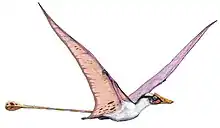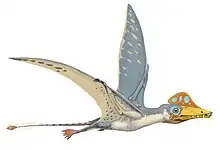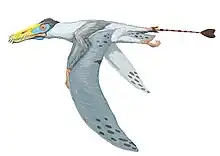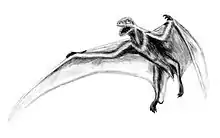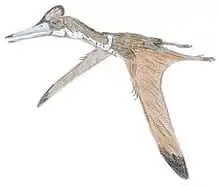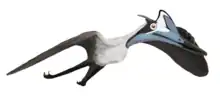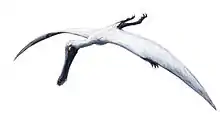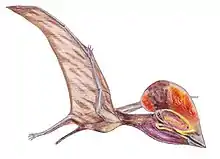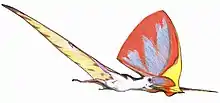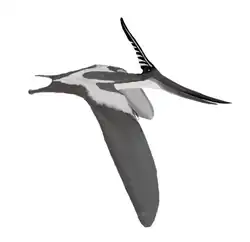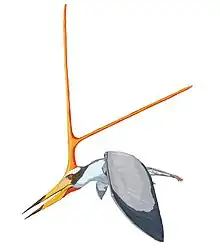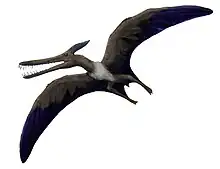| Meilifeilong Temporal range: Early Cretaceous | |
|---|---|
 | |
| Photograph (A) and line drawing (B) of the holotype specimen of M. youhao | |
| Scientific classification | |
| Domain: | Eukaryota |
| Kingdom: | Animalia |
| Phylum: | Chordata |
| Order: | †Pterosauria |
| Suborder: | †Pterodactyloidea |
| Clade: | †Azhdarchoidea |
| Clade: | †Neoazhdarchia |
| Family: | †Chaoyangopteridae |
| Genus: | †Meilifeilong Wang et al., 2023 |
| Type species | |
| †Meilifeilong youhao Wang et al., 2023 | |
| Other species | |
| |
Meilifeilong (meaning "beautiful flying dragon") is an extinct genus of chaoyangopterid pterosaurs from the Early Cretaceous Jiufotang Formation of China. The genus contains two species: M. youhao, known from an almost complete skeleton and a partial skull, and M. sanyainus, originally described as a species of Shenzhoupterus.[1] The Meilifeilong youhao holotype represents the best-preserved and most complete chaoyangopterid discovered so far.[2]
Discovery and naming
The Meilifeilong fossil materials were discovered in sediments of the Jiufotang Formation near Xiaotaizi in Jianchang County, Huludao City, of Liaoning Province, China. The holotype specimen, IVPP V 16059, consists of a nearly complete skeleton missing the tail. An additional specimen, IVPP V 17955, comprising the premaxillae, maxillae, and partial palatines of a smaller individual, was also referred to this species.[2]
In 2023, Wang et al. described Meilifeilong youhao as a new genus and species of chaoyangopterid pterosaur based on these fossil remains. The generic name, "Meilifeilong", combines the Chinese words "meili", meaning "beautiful", "fei", meaning "fly", and "long", meaning dragon, referencing the holotype's incredible quality. The specific name "youhao" means "friendship" in Mandarin, referencing the many years of collaboration on pterosaur research between Chinese and Brazilian scientists.[2]
Description
The holotype specimens of both Meilifeilong species are comparable in size; the M. youhao holotype (IVPP V 16059) has a wingspan of approximately 2.16 metres (7.1 ft), while the M. sanyainus specimen (DB0233) is slightly larger, with a wingspan of about 2.18 metres (7.2 ft). [2]
Paleoenvironment
The Meilifeilong fossil material was discovered in layers of the Jiufotang Formation, which dates to the Barremian–Aptian ages of the Early Cretaceous period. Many other pterosaurs, including additional chaoyangopterids, are also known from this formation.[2] Well-preserved fossils of many other animals, including non-avian dinosaurs, early birds, mammals, turtles, lizards, and fish, have also been found here.[3]
References
- ↑ Ji, S.; Zhang, L.; Lu, F. (2023). "A new species of chaoyangopterid pterosaur from the Early Cretaceous in western Liaoning, People's Republic of China". Acta Geologica Sinica. 97. 2023322. doi:10.19762/j.cnki.dizhixuebao.2023322.
- 1 2 3 4 5 Wang, Xiaolin; Kellner, Alexander W. A.; Jiang, Shunxing; Chen, He; Costa, Fabiana R.; Cheng, Xin; Zhang, Xinjun; Nova, Bruno C. Vila; de Almeida Campos, Diogenes; Sayão, Juliana M.; Rodrigues, Taissa; Bantim, Renan A. M.; Saraiva, Antônio A. F.; Zhou, Zhonghe (2023-12-21). "A new toothless pterosaur from the Early Cretaceous Jehol Biota with comments on the Chaoyangopteridae". Scientific Reports. 13 (1): 22642. doi:10.1038/s41598-023-48076-7. ISSN 2045-2322. PMC 10739979.
- ↑ Yu, Zhiqiang; Wang, Min; Li, Youjuan; Deng, Chenglong; He, Huaiyu (2021-12-01). "New geochronological constraints for the Lower Cretaceous Jiufotang Formation in Jianchang Basin, NE China, and their implications for the late Jehol Biota". Palaeogeography, Palaeoclimatology, Palaeoecology. 583: 110657. doi:10.1016/j.palaeo.2021.110657.
